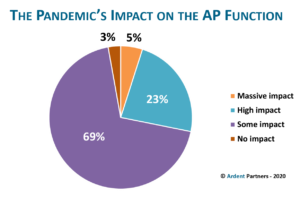[Editor’s Note: Ardent released its 15th annual “State of ePayables 2020: Ensuring Continuity, Building Resiliency, and Rising to the Challenge” market research report. Click to get your copy.]
Last week we took a look at the impact of the COVID-19 pandemic on overall business operations, this week we delve into its impact on AP operations. The pandemic forced stay-at-home restrictions on a majority of workers in North America, Western Europe, Asia-Pacific, and in other developed nations, causing great unrest at the company, community, family, and personal levels. No matter an individual’s view on the risk that the virus has posed (and continues to pose), AP staffers have been uniformly impacted by the need to work in an entirely new setting, essentially cut-off from their co- workers and their daily routines. The impact has been felt within the enterprise and across the supply chain – Ardent Partners’ State of ePayables 2020 research (click to download your copy today) study found that forty-three percent (43%) of businesses say that disruptions have been most severely felt in the supply chain and with their supplier relationships, followed by internal operations (28%). While many of the initial supply chain challenges were focused on supply assurance, the financial relationships of buyers and sellers are also being tested.
At the AP departmental level the picture was quite a bit different. While 97% of AP organizations reported having been affected by the coronavirus crisis, the overall impact (see figure below) has been less severe within AP as compared to overall business operations. A relatively low 28% of AP groups reported the impact over the past three months was either “extraordinary” or “significant”, while a much larger group (69%) rated the impact as only “fair. The depth of the impact within AP can is tied and directly correlated to the levels of automation within AP departments.

I spoke with an Assistant Controller a couple of weeks ago who said “Since all of our processes are manual, our AP team was defined as essential and had to work from the office. Of course, with a majority of my company working from home, processing paper approvals is slow to come.” Other AP professionals I spoke with noted the relative ease of transitioning to a remote environment. The difference in most cases was linked to the level of AP automation that exists, and the teams’ relative competency using it. A Director of AP told me “We were able to successfully transition to working remotely in a short period of time due to the automation tools we had in place.”
It goes without saying that those organizations which had already introduced full or even partial automation were in a much better position to handle the remote, work at home, mandates that were quickly enacted. Enterprises still relying on manual, paper-based processes faced (and continue to face) a much more difficult reality of requiring AP staff to work from their offices to receive, process, and pay invoices or at a minimum travel to their offices to pick up the invoices and bring them home for processing, approval, and payment.
It is a strange time when a laggard AP team is defined as “essential” due solely to the fact that they are behind the curve and are required to physically handle supplier invoices. It will take time to see the longer term effects, but the COVID-19 pandemic has exacerbated an already existing operational problem for some AP teams, while expanding the divide between leading and laggard performers. The pandemic also makes it evidently clear that while manual processes impede efficiency and visibility, they can also threaten business continuity and organizational resilience.
RELATED RESEARCH


